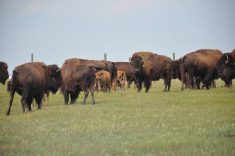LINDELL BEACH, B.C. – Researchers have created a detailed family tree for cattle and other ruminants that reaches back 29 million years.
The international team of scientists prepared ancient DNA with a scientific technique developed specifically to genotype cattle.
The genetic information will give scientists an insight into the evolution of cattle.
As well, the techniques they developed can be used to help farmers breed healthier and more efficient herds.
Their research findings were published in the Proceedings of the National Academy of Sciences this fall.
Read Also

Trump’s tariffs take their toll on U.S. producers
U.S. farmers say Trump’s tariffs have been devastating for growers in that country.
“We studied 678 animals representing 61 different species and using the new Illumina cow ‘SNP chip,’ or ‘snip chip,’ we were able to generate some very precise genetic data for which the chip was not (originally) designed,” said Jeremy Taylor, an animal genomics professor at the University of Missouri and lead author of the study.
“Our SNP chips allow scientists to examine hundreds of thousands of points on an animal’s genome simultaneously. When we applied this technique to 48 recognized breeds of cattle, we were able to construct a family tree and infer the history of cattle domestication and breed formation across the globe.”
Taylor said the Illumina Bovine SNP50 BeadChip allows the simultaneous genotyping of 54,001 single nucleotide polymorphism (SNP) bases in a single reaction.
An SNP is a single base in the DNA sequence that varies within a population to give each individual its unique genetic profile.
“The real breakthrough of this type of assay is that an enormous number of positions within the genome can be queried in one reaction, which allows very large amounts of data to be produced very quickly and relatively inexpensively.”
The team genotyped species that were evolutionarily close to the cow such as bison and water buffalo. They were looking for genetic variations, but the results gave them enough data to build a detailed family tree of 61 species of ruminants.
“We were able to propose 17 new relationships among species and provide increased support for 16 previously proposed relationships among these species.”
The research provided insights into the history of European cattle and their domestication as they spread through Turkey, the Balkans, Italy, and Central and Western Europe.
“The tree that we were able to generate clearly shows the paths by which cattle migrated through Europe as nomadic peoples wandered along the river valleys,” Taylor said.
“These animals evolved in isolation to become the many breeds we know today. One very interesting finding is that the breeds of (New World) cattle, the Texas Longhorn and the Corriente, were clearly brought here by the early Spanish explorers and they are quite different from … breeds in France, Switzerland, Austria and Italy. Our tree suggests these cattle might have been extensively influenced by African taurine animals.”
The technology will not only help determine the breeding value of young stock but also the individual genetic merits of dairy and beef cattle for specific qualities such as feed efficiency, milk quality, calf production and longevity
It can also identify an animal’s susceptibility to conditions such as Johne’s disease, a contagious chronic bacterial infection. As well, the assay could expand scientists’ understanding of human diseases.
“Cattle may be very interesting models for certain traits such as intramuscular fat,” Taylor said.
“While cattle form tiny flecks of fat within muscle depots that we call marbling, in humans that fat is more dispersed among the muscle fibres. While certain cattle and cattle breeds can actually accumulate very large amounts of intramuscular fat, which leads to beef that is prized for its tenderness and flavour, they do not appear to suffer any detrimental effects on their health.
“In humans, high amounts of intramuscular fat can lead to impaired glucose tolerance, insulin resistance and Type 2 diabetes. So identifying the genes that lead to the deposition of intramuscular fat in cattle may shed some light on the physiology of a human disease.”
Understanding how genetic variations allow high levels of marbling, feed efficiency and disease resistance in cattle could be economically significant for cattle farmers.
Similar BeadChips have been developed for sheep, hogs, poultry and horses.
Taylor said Pfizer Animal Genetics and Igenity, a wholly owned subsidiary of Merial, are at the forefront of delivering this technology and are in the process of introducing it for the beef and dairy sectors.
The testing process will involve sending a hair, buccal swab, tissue or blood sample to either of these companies. Technicians will then produce the genotypes, interpret their genetic merits and return them to breed associations or end users.
“The great advantage of the approach, we believe, is that the genetic prediction models can be generated in industry or research herds and then applied to commercial production populations,” Taylor said.














